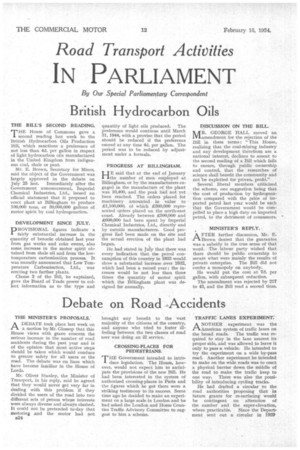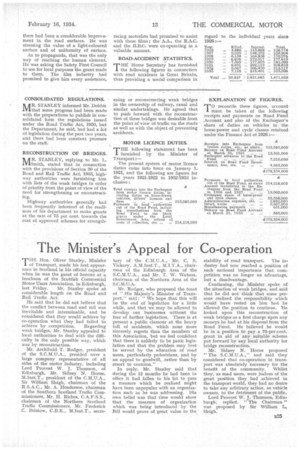Debate on Road Accidents
Page 34

Page 35

If you've noticed an error in this article please click here to report it so we can fix it.
THE MINISTER'S PROPOSALS.
ADEBATE took place last week on a motion by Mr. Glossop that this House views with grave concern the serious increase in the number of road accidents during the past year and is of the opinion that most active steps should he taken which would conduce to greater safety for all users or the road. The debate was on lines which have become familiar in the House of Lords.
Mr. Oliver Stanley, the Minister of Transport, in his reply, said he agreed that they would never get very far in dealing with this problem if they divided the users of the road into two different sets of person whose interests were always diverse and always clashed. It could not be pretended to-day that motoring and the motor had not
B24 brought any benefit to the vast majority of the citizens of the country, and anyone who tried to foster illfeeling between the two classes of road user was doing an ill service.
CROSSING-PLACES FOR PEDESTRIANS.
T"EGovernment intended to introduce legislation. The House, however, would not expect him to anticipate the provisions of the new Bill. He had been interested in the system of authorized crossing-places in Paris and the figures which he got there were a striking testimony to its success. Some time ago he decided to make an experiment on a large scale in London and ho had asked the London and Home Counties Traffic Advisory Committee to suggest to him a scheme.
TRAFFIC LANES EXPERIMENT:
ANOTHER experiment was the American system of traffic lanes on the broad roads. The traffic was required to stay in the lane nearest itsproper side, and was allowed to leave it only to pass a vehicle. He intended to try the experiment on a wide by-pass road. Another experiment he intended to make on the wide roads was to erect a physical barrier down the middle of the road to make the traffic keep to one way. There was also the possibility of introducing cycling tracks.
He had drafted a circular to the road authorities proposing that in future grants for re-surfacing would be contingent on alteration of the camber and the snper-elevation, where practicable. Since the Department sent out a circular in 192% there had been a considerable improvement in the road surfaces. He was stressing the value of a light-coloured surface and of uniformity of surface.
As to propaganda, that was the only way of reaching the human element. He was asking the Safety First Council to use for local purposes the grant made to them. The film industry had promised to give him every assistance, racing motorists had promised to assist with these films ; the A.A., the R.A.C. and the B.B.C. were co-operating in a valuable. manner. • ROAD-ACCIDENT STATISTICS.
THE Home Secretary'. has furnished the following figures in connection with road accidents in Great Britain, thus providing a useful comparison in




















































































